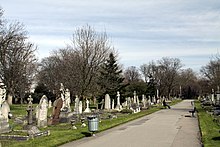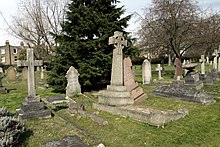

Margravine Cemetery, also known as Hammersmith Cemetery, is in the London Borough of Hammersmith and Fulham. The closest London Underground station is Barons Court.
History
Designed for the Hammersmith Burial Board by local architect George Saunders, Margravine Cemetery was opened in 1868 on a site previously occupied by market gardens and orchards, known as Fulham Fields. The first burial took place on 3 November 1869.
Margravine closed for new burials in 1951, when the 16.5 acres of cemetery land were restored by the council and designated a 'Garden of Rest'.
Notable burials and monuments


The cemetery contains a number of distinctive monuments, three of which are listed buildings. Most striking is the green bronze memorial to George Broad, who owned the foundry which made the Eros statue at Piccadilly Circus. Nearest Charing Cross Hospital, the Young family mausoleum is a single-storey building in Gothic architecture style. The third listed grave is that of an Australian gold prospector, with a bas relief of him, opposite the Young family mausoleum.
A screen wall memorial erected by the Commonwealth War Graves Commission (who list it as Hammersmith Old Cemetery) in Section 31 lists all 191 Commonwealth service personnel buried in registered war graves in the cemetery – 186 from World War I and 5 from World War II.
Two J. Lyons and Co. war memorials were relocated from their factory at Greenford to the cemetery in 2002. The World War I memorial is Grade II listed.
There is a memorial to the 13 people killed – 11 of them women – in a 1918 explosion at Blake's munitions factory, Wood Lane. It was unveiled in 1920 and Grade II listed in 2017.
Notable burials
- George Broad, brass and bronze founder
- Sir William Bull, 1st Baronet, solicitor and Conservative politician
- Fanny Eaton (1835-1924), artist's model for the Pre-Raphaelite Brotherhood
- Sir Henry Foreman (1852–1924), Conservative politician
- Peter Leitch (1820–1892), recipient of the Victoria Cross
- Thomas Nicholas (antiquary) (1816–1879), Welsh antiquary and educator
- Edward Charles Williams (1807–1881), English landscape painter
- George Wimpey (businessman) (1855–1913), founder of the construction firm of that name
- William Stephen Bond (1845-1920) founder of W S Bond local funeral directors
- Jeanne Deroin (1805-1894) Feminist,Socialist and Educationist
- Ethel Webling (1859-1929) Painter and illustrator
- Peggy Webling (1871-1949) playwright, novelist and poet

Conservation
The cemetery is now a part of the Barons Court Conservation Area, designated in April 1989.
Hammersmith and Fulham council states in its 2008 management plan that the site is designated a Nature Conservation Area of Local Importance. It is a particularly useful space for viewing migrating songbirds, bees and butterflies.
See also
- Mortlake Cemetery, also known as Hammersmith New Cemetery
References
- ^ "London Borough of Hammersmith and Fulham, Margravine Cemetery". Retrieved 2 December 2023.
- London Borough of Hammersmith and Fulham, Margravine Cemetery Management Plan 2009–2014, 2008, ""Archived copy" (PDF). Archived from the original (PDF) on 16 May 2012. Retrieved 13 January 2013.
{{cite web}}: CS1 maint: archived copy as title (link)" viewed 13 January 2013 - Margravine Cemetery Management Plan 2009–2014, London Borough of Hammersmith and Fulham, 2009, p18 "Archived copy" (PDF). Archived from the original (PDF) on 16 May 2012. Retrieved 5 April 2012.
{{cite web}}: CS1 maint: archived copy as title (link) - CWGC Cemetery Report. Breakdown obtained from Casualty Record.
- Historic England. "J Lyons and Company First World War Memorial, Margravine Cemetery (1442826)". National Heritage List for England. Retrieved 2 September 2021.
- Historic England. "Blake's Munitions War Memorial, Margravine Cemetery (1437915)". National Heritage List for England. Retrieved 31 August 2021.
- "Blakes Munition Factory – Cross". War Memorials Register. Imperial War Museum. Retrieved 31 August 2021.
- "Obituary: Sir Henry Foreman". The Times. 12 April 1924. p. 24.
- "Grave locations for holders of the Victoria Cross: West London. Archived copy". Victoriacross.org.uk. Archived from the original on 16 July 2012. Retrieved 27 January 2022.
External links
- Friends of Margravine Cemetery website
- Margravine Cemetery at Find a Grave

- London Borough of Hammersmith and Fulham, Margravine Cemetery page
51°29′20″N 0°12′55″W / 51.48889°N 0.21536°W / 51.48889; -0.21536
Categories: